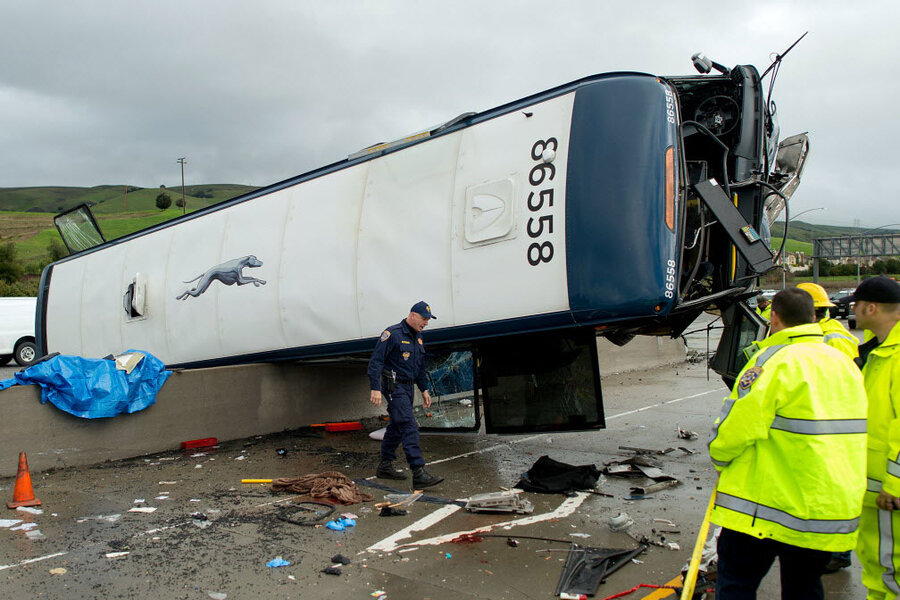Two people killed in California Greyhound crash. How safe are buses?
Loading...
A northbound Greyhound bus traveling from Los Angeles to San Francisco flipped on its side near San Jose, Calif., on Tuesday, killing two passengers and injuring 18.
Bus No. 86558 was traveling on US Highway 101 around 6:40 a.m., Pacific time, at about 70 miles per hour when it collided with barrels cordoning off a carpool lane and tipped to its side. No other vehicles were involved in the crash. In total, 39 passengers were aboard the Greyhound.
The driver, who has not been named, was taken to the hospital with unknown injuries and will be tested for alcohol and drugs, as is standard procedure, according to California Highway Patrol Officer Chris Micelli. The crash was under investigation, and officials anticipated it would take eight hours to clear the scene, which was congesting drivers on their morning commute.
Despite high-profile crashes, traffic safety has improved since 1950, progress that experts attribute to better technology, stricter regulations, and safety campaigns in cities from New York to Los Angeles. The most recent data from the Centers for Disease Control and Prevention show that the number of deaths resulting from traffic accidents has declined by more than 50 percent since the 1950s.
A 2014 report from the Centers for Disease Control and Prevention showed that traffic accidents resulted in 10.3 deaths per 100,000 people, that's
By some measures, bus safety is in line with overall vehicle safety: one 2012 study found that the number of accidents per mile was comparable for buses and private vehicles, at 3.04 and 3.21, respectively.
But the quickly-growing field of super low-cost carriers, like Bolt, presents a greater risk. Massachusetts ordered the notoriously fast-driving Fung Wah buses off the road after most of its vehicles failed inspections in 2013, for instance. And so-called curbside carriers' rate of fatal accidents was seven times higher than traditional carriers: 1.4 per 100 vehicles versus .2 per 100 carriers, respectively.
As journalist Leighton Walter Kille noted:
Because curbside services don’t use traditional bus terminals and en route inspections are prohibited by law, inspection opportunities are limited. It’s also relatively easy for sanctioned carriers to reinvent themselves with a new name, repainted buses and shifted ownership.
According to the National Transportation Safety Board, there were 6,091 motorcoach accidents between 2005 and 2010, including 191 fatal accidents.
In January, the Department of Transportation’s Federal Motor Carrier Safety Administration (FMCSA) introduced a proposal to update its motor carrier safety regulations to integrate more on-road safety data and reclassify companies as "fit" or "unfit," instead of the present system, which rates them as "satisfactory," "conditional," or "unsatisfactory."
"This update to our methodology will help the agency focus on carriers with a higher crash risk," Acting FMCSA Administrator Scott Darling said. “Carriers that we identify as unfit to operate will be removed from our roadways until they improve."
This report contains material from The Associated Press.








